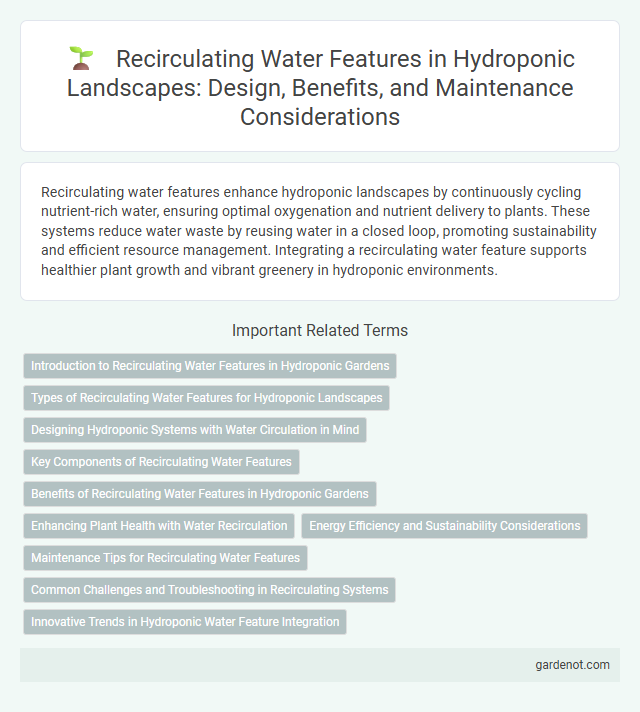Recirculating water features enhance hydroponic landscapes by continuously cycling nutrient-rich water, ensuring optimal oxygenation and nutrient delivery to plants. These systems reduce water waste by reusing water in a closed loop, promoting sustainability and efficient resource management. Integrating a recirculating water feature supports healthier plant growth and vibrant greenery in hydroponic environments.
Introduction to Recirculating Water Features in Hydroponic Gardens
Recirculating water features in hydroponic gardens enhance nutrient distribution by continuously cycling water through the system, ensuring consistent oxygenation and nutrient availability to plant roots. These systems reduce water waste by recycling nutrient solutions, improving overall efficiency and sustainability in hydroponic setups. Key components include pumps, reservoirs, and filters that maintain water quality and support optimal plant growth.
Types of Recirculating Water Features for Hydroponic Landscapes
Recirculating water features in hydroponic landscapes include fountains, waterfalls, and water walls, each promoting nutrient distribution and oxygenation critical for plant growth. Fountains aerate water by creating spray patterns that enhance nutrient uptake, while waterfalls increase dissolved oxygen levels by agitating the water flow. Water walls offer a vertical nutrient film technique, optimizing space and ensuring continuous circulation for root hydration and nutrient absorption.
Designing Hydroponic Systems with Water Circulation in Mind
Designing hydroponic systems with effective water circulation enhances nutrient distribution and oxygenation, critical for optimal plant growth in recirculating water features. Incorporating pumps with adjustable flow rates and strategically placed inlet and outlet points ensures uniform water movement, preventing stagnation and root rot. Using biofilters and UV sterilizers within the water circulation loop maintains water quality, supporting a healthy hydroponic landscape ecosystem.
Key Components of Recirculating Water Features
Recirculating water features in hydroponic landscapes consist of essential components such as a water pump, reservoirs, tubing, and filtration systems that ensure continuous water flow and nutrient circulation. The pump moves nutrient-rich water through tubing to the plant roots, while filtration systems prevent debris buildup, maintaining water quality and system efficiency. Proper integration of these components supports optimal plant growth by providing consistent hydration and nutrients in a controlled environment.
Benefits of Recirculating Water Features in Hydroponic Gardens
Recirculating water features in hydroponic gardens enhance nutrient efficiency by continuously cycling water infused with essential minerals, promoting optimal plant growth. These systems reduce water waste and lower maintenance by maintaining consistent hydration and aeration levels. Improved oxygenation from recirculating water supports root health and accelerates nutrient uptake, resulting in higher crop yields.
Enhancing Plant Health with Water Recirculation
Recirculating water features in hydroponic landscapes optimize nutrient distribution and oxygenation, promoting robust root development and overall plant health. Continuous water movement prevents stagnation, reducing the risk of disease and ensuring consistent delivery of essential minerals. Implementing advanced filtration and aeration systems further enhances water quality, supporting sustainable growth and higher crop yields.
Energy Efficiency and Sustainability Considerations
Recirculating water features in hydroponic landscapes significantly reduce water consumption by continuously cycling the same water, enhancing overall energy efficiency. Incorporating energy-efficient pumps and solar-powered systems further minimizes the carbon footprint while maintaining optimal nutrient delivery for plant growth. Sustainable design integrates water purification technology to prevent nutrient runoff, ensuring environmental protection and long-term resource conservation.
Maintenance Tips for Recirculating Water Features
Regularly check and clean the water pump and filters in recirculating water features to prevent clogs and ensure efficient water flow. Monitor water quality by testing pH levels and removing algae buildup to maintain a healthy hydroponic environment. Periodic water replacement and inspection of tubing for leaks prolong the system's lifespan and optimize plant growth.
Common Challenges and Troubleshooting in Recirculating Systems
Recirculating water features in hydroponic landscapes often face challenges such as algae buildup, pump malfunctions, and nutrient imbalances that disrupt plant growth. Regular monitoring of pH levels, water temperature, and filtration systems is crucial to prevent clogging and maintain optimal water quality. Implementing automatic sensors and routine maintenance schedules can effectively troubleshoot common issues and ensure system efficiency.
Innovative Trends in Hydroponic Water Feature Integration
Recirculating water features in hydroponic landscapes utilize advanced filtration systems and sensor-driven pumps to maintain optimal water quality and nutrient levels, promoting sustainable growth. Integration of IoT technology allows real-time monitoring and automated adjustments, enhancing plant health and conserving water resources. Innovative trends include the use of biofiltration and smart aeration techniques that improve oxygenation and reduce algae buildup in closed-loop hydroponic water systems.
Recirculating water feature Infographic

 gardenot.com
gardenot.com